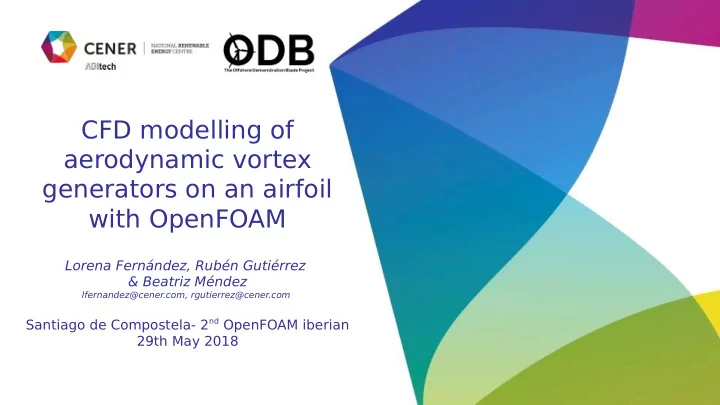

CFD modelling of aerodynamic vortex generators on an airfoil with OpenFOAM Lorena Fernández, Rubén Gutiérrez & Beatriz Méndez lfernandez@cener.com, rgutierrez@cener.com Santiago de Compostela- 2 nd OpenFOAM iberian 29th May 2018
Outline of the presentation 1. Introduction m 2 . 1 7 1 2. Geometry Ø 3. Mesh 196.2 m 4. CFD simulations 5. Conclusions & future work 2
1. INTRODUCTION Vortex generators delay separation in the airfoil to higher angles of attack and increase the maximum lift. Vortex generators create longitudinal vortices that mix high momentum air form the outer flow down to the boundary layer near the surface making the flow more resistant to separation. Drawback: drag penalty Low drag Vortex Generators 3
2. GEOMETRY Case background Geometry A pseudo-2d approach is done. A segment of the blade is simulated with the following assumptions: Vortex generators ~ 5 mm implementation on different ● Constant twist and chord. blade regions ● 2D flow without rotational effects. ● Fixed inflow velocity. (Fixed AoA). m m 0 3 ~ Chord = 1m Simulated region ● Boundary located at 25 chords. ● The Reynolds number is 6 millions ● cells of the mesh 10 millions Leading Edge Protection System 4
3. MESH Efficient meshing: Mesh in 3 parts (merged and use of AMIs) 5
3. MESH Meshing tools: Cf-Mesh ICEM-CFD Salome-Meca Solution with more elements in BL region Equal BL parameters BL limitation (VG & Airfoil surfaces) 6
3. MESH Avoid extension of boundary layer thickness, causing large aspect ratio cells. Propagation nodes problem O-grid Solution 7
4. CFD SIMULATION OpenFOAM version 5 Solver SIMPLEC Algorithm Steady-state solver SimpleFOAM fvSolution Consistent true Schemes Grad → cellMDLimited Gauss linear 1 Div → bounded Gauss linearUpwind Laplacian → Gauss Linear Limited 0.5 Interpolation → linear snGrad → limited 0.5 8
5. CFD SIMULATION Boundary conditions Name Condition Regions FalField freestream Far field at 25m from the airfoil With the velocity indicated with respect to AoA Slip slip (or empty without the VG, a 2D case) Sides of the domain AMI cyclicAMI Interfaces between 3 mesh pieces Walls wall Airfoil profile and the VGs Slip Far field AMI AMI Slip Walls 9
4. CFD SIMULATION 3 2 Turbulence model 1 Clean situation: Transitional model K-KL Dirty situation (Fully-Turbulent): Fully-turbulent model KW-SST (Chosen model) 1. Upstream the LEPS 2. At LEPS 3.Downstream the LEPS 10
4. CFD SIMULATION Turbulence model Spallart Allmaras K-Epsilon K-Omega Good flow and Good flow but the Non realistic flow “vortex” but a wrong flow is “vortex” generated by the VG downstream are not well captured Slice (Normal to x) Slice (Normal to x) Slice (Normal to x) 11
4. CFD SIMULATION Initialization K-Epsilon as a good initialization turbulence model K-Omega K-Epsilon (first) K-Omega U field from use potentialFoam 12
5. CONCLUSIONS & FUTURE WORK Conclusions ● Optimize the CFD study of a VG and an cross-section of an airfoil ● Study difgerent VG and airfoil shapes ● Meshing strategy optimized ● Initialization was solved Future work ● CFD 3D for all the blade ● K-KL turbulence model without LEPS ● T ransient solver ● Semi-empirical models (Wendt,Bay…) avoiding fully-mesh computations ● Simulate only the VG’s infmuence area with airfoil profjles’s boundary layer as an input 13
Thanks for your atuentjon. Questjons? ¡THANK YOU!
Recommend
More recommend